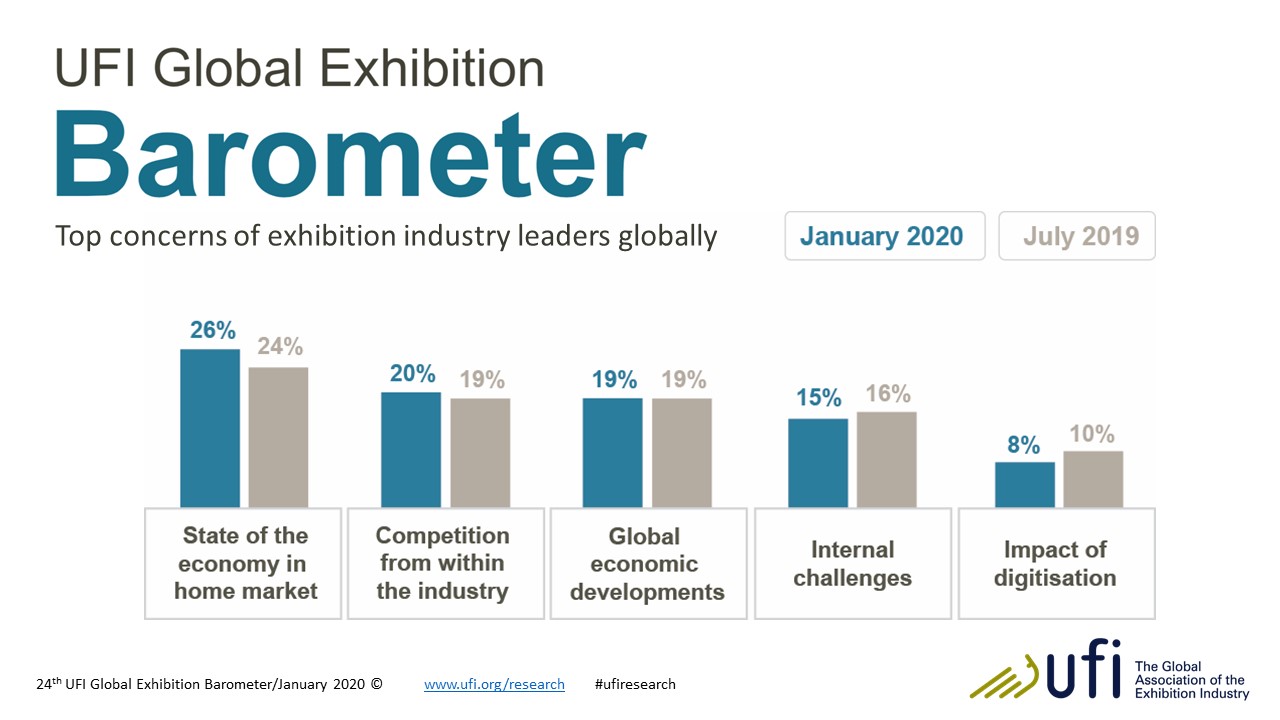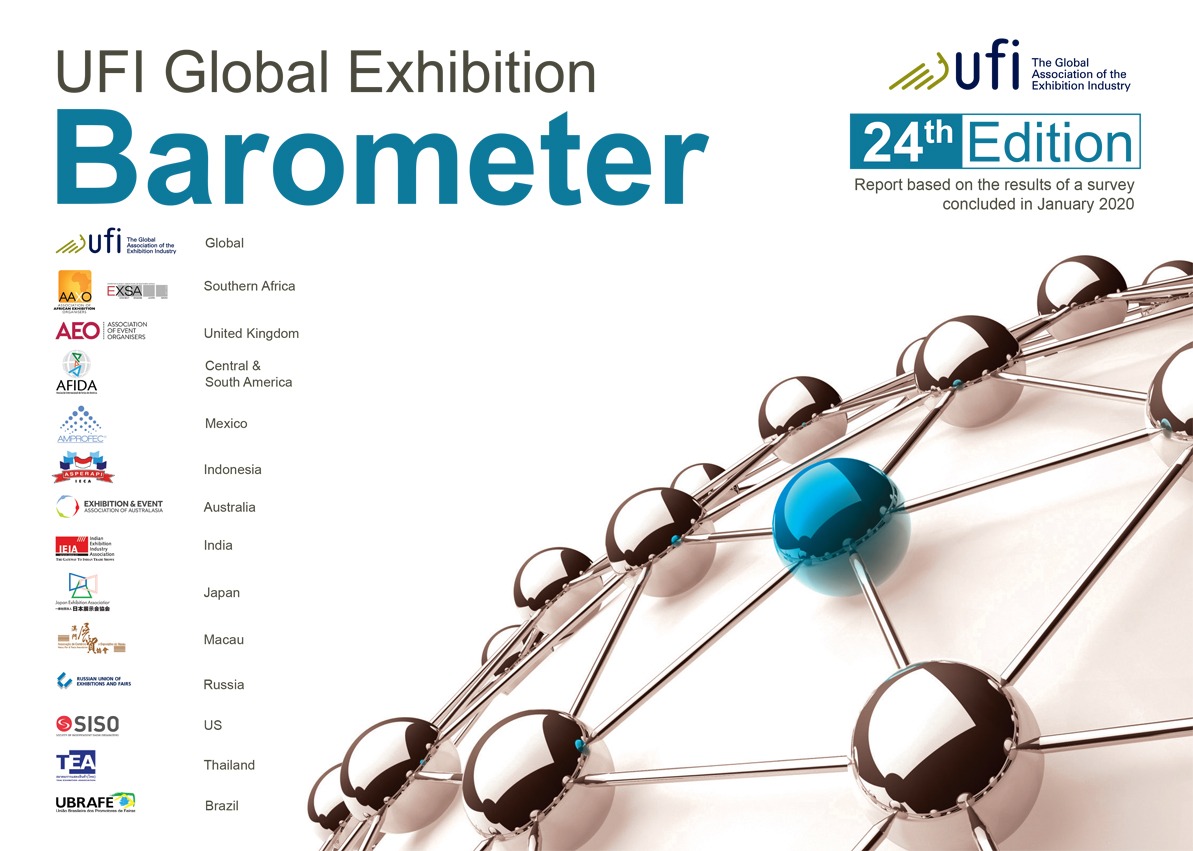
-
UFI’s Global Barometer confirms positive operating profits for 2019
-
Turnover expectations for 2020 – surveyed immediately before the coronavirus spread – are positive, but with strong levels of uncertainty in many countries
-
The state of the economy at home, global economic developments and competition within the industry remain the top three issues faced by companies
-
Study delivers dedicated profiles for 22 markets and regions, including – for the first time – the United Arab Emirates
A new report on the state of the exhibitions industry and key issues going forward has been released by UFI.
Its Global Barometer report confirms strong industry performance for 2019, but also a higher level of uncertainty when looking towards 2020 in many countries, especially in the Asia-Pacific region and Latin America.
The survey reveals a positive result in terms of operating profit, with at least 70 per cent of companies in each of the four regions maintaining a good level of performance in 2019 compared to 2018.
The majority of companies from all regions also expect an increase in gross turnover. However, there is uncertainty in many countries, even prior to the coronavirus issue.
Results also indicate that the key issue for the industry remains the ‘state of the economy at home’ (selected by 26 per cent of all respondents). This is ahead of ‘competition within the industry’ (20 per cent) and ‘global economic developments’ (19 per cent).

In recent editions of this long-running UFI research, there has been a trend towards this focus on the national/regional economy over global economic development.
In terms of strategy, in all regions, a large majority of companies intend to develop new activities, either with classic exhibition industry initiatives and/or by moving outside current product portfolios.
In terms of geographical expansion, on average globally, more than one company out of three declares an intention to develop operations in new countries.
The survey also tackles the evolution of the exhibition business model and to what extent specific features are implemented.
The results indicate a major use of “conference stages on and near the show floor” (3.6 out of a scale of 5).
“Exhibitions grew again in 2019, but a slowdown is expected for the beginning of 2020. The novel coronavirus outbreak, which has already led to many shows being postponed or cancelled in China and Asia, will impact this as well. We all hope this situation settles quickly, as the exhibition industry is using these results to shape its general development plans and how it’s adapting to the continually evolving classic business model,” said Kai Hattendorf, Managing Director and CEO, UFI.
Size and scope
This latest edition of UFI’s bi-annual industry survey was concluded in January 2020 and includes data from a record 438 companies in 70 countries and regions.
The study delivers outlooks and analysis for 18 countries and regions: Argentina, Australia, Brazil, China, Colombia, Germany, India, Indonesia, Italy, Japan, Macau, Mexico, Russia, South Africa, Thailand, the UAE (for the first time), the UK and the US. In addition, it analyses four aggregated regional zones.
Economic developments
In all regions, the majority of companies (those in a position to assess their turnover), expect an increase in gross turnover.
Eight of the selected countries have, for the three periods surveyed, a majority of companies declaring an increase in turnover: Australia, Brazil, Germany, India, Indonesia, Russia, the UAE and the USA.
However, significant levels of uncertainty over the period are recorded in Argentina, China, Macau, Japan, Mexico and the UK.
In terms of operating profit, the highest proportion of companies declaring an increase of more than 10 per cent are observed in the USA (62 per cent), Brazil (50 per cent), Germany (42 per cent), Thailand (42 per cent) and India (41 per cent). Conversely, the lowest proportion of companies are in Indonesia (29 per cent), Russia (29 per cent), Australia (28 per cent), South Africa (24 per cent), the UAE (11 per cent), Macau (0 per cent) and the UK (0 per cent).
Key business issues
Around 80 per cent of all answers relate to the following four issues: ‘State of the economy at home’ (26 per cent in the current survey, up two per cent compared to six months ago), ‘competition within the industry’ (20 per cent in the current survey, up one per cent compared to six months ago), ‘global economic developments’ (19 per cent in the current survey, same as six months ago), ‘internal challenges’ (16 per cent in the current survey, down one per cent compared to six months ago), where ‘human resources’ are named as the most important aspect.
Strategy
Some 79 per cent of companies in the Asia-Pacific region, 87 per cent in the Middle East and Africa, 90 per cent in Europe and 93 per cent in the Americas intend to develop new activities, in either the classic range of exhibition industry activities (venue/organiser/services) and/or moving outside current product portfolios.
In terms of geographical expansion, 36 per cent of companies on average declare an intention to develop operations in new countries, and this is the case for the majority of companies in seven of the 22 markets analysed: Germany (73 per cent), the UK (73 per cent), South Africa (64 per cent), other Middle Eastern countries (56 per cent), Brazil (50 per cent), Italy (50 per cent) and the USA (50 per cent).
Evolution
The 24th Global Barometer survey looked into how the exhibition model is evolving, by questioning companies as to what extent specific features are implemented, as well as the share of available space used for these features.
Results indicate a major use of conference stages on and near the show floor (3.6 out of a scale of five), followed by open meeting spaces (2.9) and catering/designated food spaces (2.8). Off main site events are, by comparison, less common (2.0). These features occupy on average less than 10 per cent of the total space of the exhibitions. The survey results reveal various stages of development and diverging focal points across different markets and regions.

